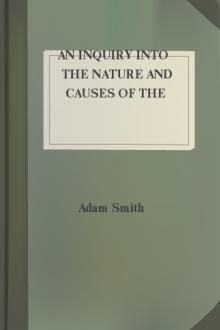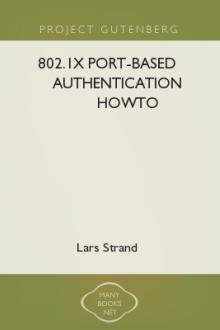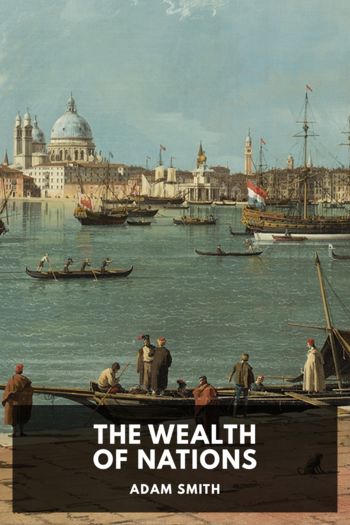An Inquiry into the Nature and Causes of the Wealth of Nations, Adam Smith [e book reader pdf TXT] 📗

- Author: Adam Smith
- Performer: 0226763749
Book online «An Inquiry into the Nature and Causes of the Wealth of Nations, Adam Smith [e book reader pdf TXT] 📗». Author Adam Smith
less, in proportion to the price of corn, that of every sort of animal food,
so it as necessarily lowers that of, I believe, every sort of vegetable
food. It raises the price of animal food ; because a great part of the land
which produces it, being rendered fit for producing corn, must afford to the
landlord anti farmer the rent and profit of corn land. It lowers the price
of vegetable food; because, by increasing the fertility of the land, it
increases its abundance. The improvements of agriculture, too, introduce
many sorts of vegetable food, which requiring less land, and not more labour
than corn, come much cheaper to market. Such are potatoes and maize, or what
is called Indian corn, the two most important improvements which the
agriculture of Europe, perhaps, which Europe itself, has received from the
great extension of its commerce and navigation. Many sorts of vegetable
food, besides, which in the rude state of agriculture are confined to the
kitchen-garden, and raised only by the spade, come, in its improved state,
to be introduced into common fields, and to be raised by the plough ; such
as turnips, carrots, cabbages, etc. If, in the progress of improvement,
therefore, the real price of one species of food necessarily rises, that of
another as necessarily falls ; and it becomes a matter of more nicety to
judge how far the rise in the one may be compensated by the fall in the
other. When the real price of butcher’s meat has once got to its height
(which, with regard to every sort, except perhaps that of hogs flesh, it
seems to have done through a great part of England more than a century ago),
any rise which can afterwards happen in that of any other sort of animal
food, cannot much affect the circumstances of the inferior ranks of people.
The circumstances of the poor, through a great part of England, cannot
surely be so much distressed by any rise in the price of poultry, fish,
wild-fowl, or venison, as they must be relieved by the fall in that of
potatoes.
In the present season of scarcity, the high price of corn no doubt
distresses the poor. But in times of moderate plenty, when corn is at its
ordinary or average price, the natural rise in the price of any other sort
of rude produce cannot much affect them. They suffer more, perhaps, by the
artificial rise which has been occasioned by taxes in the price of some
manufactured commodities, as of salt, soap, leather, candles, malt, beer,
ale, etc.
Effects of the Progress of Improvement upon the real Price of Manufactures.
It is the natural effect of improvement, however, to diminish gradually the
real price of almost all manufactures. That of the manufacturing workmanship
diminishes, perhaps, in all of them without exception. In consequence of
better machinery, of greater dexterity, and of a more proper division and
distribution of work, all of which are the natural effects of improvement, a
much smaller quantity of labour becomes requisite for executing any
particular piece of work ; and though, in consequence of the flourishing
circumstances of the society, the real price of labour should rise very
considerably, yet the great diminution of the quantity will generally much
more than compensate the greatest rise which can happen in the price.
There are, indeed, a few manufactures, in which the necessary rise in the
real price of the rude materials will more than compensate all the
advantages which improvement can introduce into the execution of the work In
carpenters’ and joiners’ work, and in the coarser sort of cabinet work, the
necessary rise in the real price of barren timber, in consequence of the
improvement of land, will more than compensate all the advantages which can
be derived from the best machinery, the greatest dexterity, and the most
proper division and distribution of work.
But in all cases in which the real price of the rude material either does
not rise at all, or does not rise very much, that of the manufactured
commodity sinks very considerably.
This diminution of price has, in the course of the present and preceding
century, been most remarkable in those manufactures of which the materials
are the coarser metals. A better movement of a watch, than about the middle
of the last century could have been bought for twenty pounds, may now
perhaps be had for twenty shillings. In the work of cutlers and locksmiths,
in all the toys which are made of the coarser metals, and in all those goods
which are commonly known by the name of Birmingham and Sheffield ware, there
has been, during the same period, a very great reduction of price, though
not altogether so great as in watch-work. It has, however, been sufficient
to astonish the workmen of every other part of Europe, who in many cases
acknowledge that they can produce no work of equal goodness for double
or even for triple the price. There are perhaps no manufactures, in which
the division of labour can be carried further, or in which the machinery
employed admits of’ a greater variety of improvements, than those of which
the materials are the coarser metals.
In the clothing manufacture there has, during the same period, been no such
sensible reduction of price. The price of superfine cloth, I have been
assured, on the contrary, has, within these five-and-twenty or thirty years,
risen somewhat in proportion to its quality, owing, it was said, to a
considerable rise in the price of the material, which consists altogether of
Spanish wool. That of the Yorkshire cloth, which is made altogether of
English wool, is said, indeed, during the course of the present century, to
have fallen a good deal in proportion to its quality. Quality, however, is
so very disputable a matter, that I look upon all information of this kind
as somewhat uncertain. In the clothing manufacture, the division of labour
is nearly the same now as it was a century ago, and the machinery employed
is not very different. There may, however, have been some small improvements
in both, which may have occasioned some reduction of price.
But the reduction will appear much more sensible and undeniable, if we
compare the price of this manufacture in the present times with what it was
in a much remoter period, towards the end of the fifteenth century, when the
labour was probably much less subdivided, and the machinery employed much
more imperfect, than it is at present.
In 1487, being the 4th of Henry VII., it was enacted, that ” whosoever shall
sell by retail a broad yard of the finest scarlet grained, or of other
grained cloth of the finest making, above sixteen shillings, shall forfeit
forty shillings for every yard so sold.” Sixteen shillings, therefore,
containing about the same quantity of silver as four-and-twenty shillings of
our present money, was, at that time, reckoned not an unreasonable price for
a yard of the finest cloth; and as this is a sumptuary law, such cloth, it
is probable, had usually been sold somewhat dearer. A guinea may be reckoned
the highest price in the present times. Even though the quality of the
cloths, therefore, should be supposed equal, and that of the present times
is most probably much superior, yet, even upon this supposition, the money
price of the finest cloth appears to have been considerably reduced since
the end of the fifteenth century. But its real price has been much more
reduced. Six shillings and eightpence was then, and long afterwards,
reckoned the average price of a quarter of wheat. Sixteen shillings,
therefore, was the price of two quarters and more than three bushels of
wheat. Valuing a quarter of wheat in the present times at eight-and-twenty
shillings, the real price of a yard of fine cloth must, in those times, have
been equal to at least three pounds six shillings and sixpence of our
present money. The man who bought it must have parted with the command of a
quantity of labour and subsistence equal to what that sum would purchase in
the present times.
The reduction in the real price of the coarse manufacture, though
considerable, has not been so great as in that of the fine.
In 1463, being the 3rd of Edward IV. it was enacted, that “no servant in
husbandry nor common labourer, nor servant to any artificer inhabiting out
of a city or burgh, shall use or wear in their clothing any cloth above two
shillings the broad yard.” In the 3rd of Edward IV., two shillings contained
very nearly the same quantity of silver as four of our present money. But
the Yorkshire cloth which is now sold at four shillings the yard, is
probably much superior to any that was then made for the wearing of the very
poorest order of common servants. Even the money price of their clothing,
therefore, may, in proportion to the quality, be somewhat cheaper in the
present than it was in those ancient times. The real price is certainly a
good deal cheaper. Tenpence was then reckoned what is called the moderate
and reasonable price of a bushel of wheat. Two shillings, therefore, was the
price of two bushels and near two pecks of wheat, which in the present
times, at three shillings and sixpence the bushel, would be worth eight
shillings and ninepence. For a yard of this cloth the poor servant must have
parted with the power of purchasing a quantity of subsistence equal to what
eight shillings and ninepence would purchase in the present times. This is a
sumptuary law, too, restraining the luxury and extravagance of the poor.
Their clothing, therefore, had commonly been much more expensive.
The same order of people are, by the same law, prohibited from wearing hose,
of which the price should exceed fourteen-pence the pair, equal to about
eight-and-twenty pence of our present money. But fourteen-pence was in those
times the price of a bushel and near two pecks of wheat; which in the
present times, at three and sixpence the bushel, would cost five shillings
and threepence. We should in the present times consider this as a very high
price for a pair of stockings to a servant of the poorest and lowest order.
He must however, in those times, have paid what was really equivalent to
this price for them.
In the time of Edward IV. the art of knitting stockings was probably not
known in any part of Europe. Their hose were made of common cloth, which may
have been one of the causes of their dearness. The first person that wore
stockings in England is said to have been Queen Elizabeth. She received them
as a present from the Spanish ambassador.
Both in the coarse and in the fine woollen manufacture, the machinery
employed was much more imperfect in those ancient, than it is in the present
times. It has since received three very capital improvements, besides,
probably, many smaller ones, of which it may be difficult to ascertain
either the number or the importance. The three capital improvements are,
first, the exchange of the rock and spindle for the spinning-wheel, which,
with the same quantity of labour, will perform more than double the quantity
of work. Secondly, the use of several very ingenious machines, which
facilitate and abridge, in a still greater proportion, the winding of the
worsted and woollen yarn, or the proper arrangement of the warp and woof
before they are put into the loom ; an operation which, previous to the
invention of those machines, must have been extremely tedious and
troublesome.Thirdly, the employment of the fulling-mill for thickening the
cloth, instead of treading it in water. Neither wind nor water mills of any
kind were known in England





Comments (0)